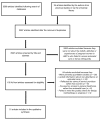Why do women not use antenatal services in low- and middle-income countries? A meta-synthesis of qualitative studies
- PMID: 23349622
- PMCID: PMC3551970
- DOI: 10.1371/journal.pmed.1001373
Why do women not use antenatal services in low- and middle-income countries? A meta-synthesis of qualitative studies
Abstract
Background: Almost 50% of women in low- and middle-income countries (LMICs) don't receive adequate antenatal care. Women's views can offer important insights into this problem. Qualitative studies exploring inadequate use of antenatal services have been undertaken in a range of countries, but the findings are not easily transferable. We aimed to inform the development of future antenatal care programmes through a synthesis of findings in all relevant qualitative studies.
Methods and findings: Using a predetermined search strategy, we identified robust qualitative studies reporting on the views and experiences of women in LMICs who received inadequate antenatal care. We used meta-ethnographic techniques to generate themes and a line-of-argument synthesis. We derived policy-relevant hypotheses from the findings. We included 21 papers representing the views of more than 1,230 women from 15 countries. Three key themes were identified: "pregnancy as socially risky and physiologically healthy", "resource use and survival in conditions of extreme poverty", and "not getting it right the first time". The line-of-argument synthesis describes a dissonance between programme design and cultural contexts that may restrict access and discourage return visits. We hypothesize that centralised, risk-focused antenatal care programmes may be at odds with the resources, beliefs, and experiences of pregnant women who underuse antenatal services.
Conclusions: Our findings suggest that there may be a misalignment between current antenatal care provision and the social and cultural context of some women in LMICs. Antenatal care provision that is theoretically and contextually at odds with local contextual beliefs and experiences is likely to be underused, especially when attendance generates increased personal risks of lost family resources or physical danger during travel, when the promised care is not delivered because of resource constraints, and when women experience covert or overt abuse in care settings.
Conflict of interest statement
The authors have declared that no competing interests exist.
Figures
References
-
- Hogan MC, Foreman KJ, Naghavi M, Ahn SY, Wang M, et al. (2010) Maternal mortality for 181 countries, 1980—2008: a systematic analysis of progress towards Millennium Development Goal 5. Lancet 375: 1609–1623. - PubMed
-
- United Nations (2011) The Millennium Development Goals report 2011. New York: United Nations.
-
- United Nations (2000) United Nations millennium declaration. Fifty-fifth session of the United Nations General Assembly. New York: United Nations.
-
- World Health Organization, United Nations Children's Fund, United Nations Population Fund, The World Bank (2010) Trends in maternal mortality: 1990–2008. Geneva: World Health Organization.
-
- World Health Organization, United Nations Children's Fund (2012) Countdown to 2015: building a future for women and children—the 2012 report. Available: http://countdown2015mnch.org/documents/2012Report/2012-Complete.pdf. Accessed 3 December 2012.
MeSH terms
LinkOut - more resources
Full Text Sources
Other Literature Sources
Medical



